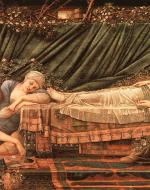Created by Giovanna Scarabaggio on Thu, 10/22/2020 - 22:23
Description:
Edward Burne-Jones was a talented artist who created all different types of art from paintings, book illustrations, stained glass, jewelry, painted furniture, watercolors etc. He also enjoyed creating sequences of images that all were part of one narrative (Newall). This is seen for example in the St Frideswide stained glass and experience of designing illustrations for The Earthly Paradise and during the 1860s when he created a cycle of paintings on the theme of St George that included seven paintings (Newall). This type of style shows his ability to display a certain theme at different moments. Another series he created was the Holy Grail series (1895-96), designed for the dining-room of an English country estate (May). “These works, with their densely patterned designs, masterful figure compositions and shimmering complementary colours, summarize Burne-Jones's lifelong fascination with the Arthurian legend and romantic symbolism” (May).
Not many other artists have attempted to create these types of amazing series. His other series included, the Perseus Series (1875-85), and three of the four canvases depicting the story of The Briar Rose (1872-92) (May). The Briar Rose was based on the story of The Sleeping Beauty and this enormous (49” x 104”) work is in the collection of the Delaware Art Museum (May). This series is among the great masterpieces of late Victorian decorative art.
The Legend of the Briar Rose is identified as “as the epitome of this putative tendency to withdraw from the horrors of modernity into a hallucinatory realm of sleep, dreams, and legends” (Rager 1). This series includes four approximately four- by seven-foot canvases, The Briar Wood, The Council Chamber, The Garden Court, and The Rose Bower (Rager 1). When it was completed in 1890, the Briar Rose series was displayed in its own dedicated gallery at Agnew & Sons and it was greeted with large crowds (Rager 5). Burne-Jones was not afraid to challenge the norms of art during the Victorian Era. “With the Briar Rose series, Burne-Jones sought to dramatize the struggle for personal, social, artistic, and even environmental awakening, rather than reveling in the contentment of sleepy stasis”( Rager 4).
The last image of this series is The Rose Bower. This beautiful and dreamy image shows sleeping beauty on her bed surrounded by her sleeping attendants. This image displays four beautiful women during what seems to be a Victorian “slumber party.” The woman on the bed is wearing a white nightgown while her female attendants are wearing dark colored dresses that resemble the style of dress during the Victorian Era. All the women are given realistic body types and each of them have red hair. They seem to be sleeping very relaxed. Their facial expressions show four women in a very deep and peaceful sleep. The three attendants are sitting and laying on the floor around the woman on the bed. Roses are seen circling the drapery in the background and there is an inscription under the painting that reads:
“Here lies the hoarded love, the key
To all the treasure that shall be;
Come fated hand the gift to take
And smite this sleeping world awake.”
This image is very eye catching because it includes vibrant colors. The women are sleeping in a room filled with reds, greens, and blues. The matching furniture and detailed bedding demonstrates the wealth the woman on the bed has. On the floor, there is a small green chest with a lot of detail. Next to the chest, there is a hand mirror and hair comb that reminds me of the type of mirrors that are seen in many of the classic Disney princess movies. It seems that the women are sleeping on an outdoor patio or balcony surrounded by roses. There is a large green drapery that gives the women privacy from the public. The way the three attendants are lying leaning against each other and the woman’s bed gives off the impression that they are exhausted while the one woman sleeps peacefully on her back. The poem that Burne-Jones includes with this image creates a dialogue between the women in the painting and the viewer and gives off a mysterious tone.
The Legend of the Briar Rose was inspired by a simple children’s fairy tale but proved to be one of Burne-Jones’s greatest artistic endeavors and influenced the world of art as we know it.
Works Cited
May, Stephen. “The Art of Edward Burne-Jones.” British Heritage, vol. 20, no. 1, Dec. 1998, p. 32. EBSCOhost, search.ebscohost.com/login.aspx?direct=true&db=ulh&AN=1239595&site=ehost-live&scope=site.
Newall, Christopher. "Jones, Sir Edward Coley Burne-, first baronet (1833–1898), painter." Oxford Dictionary of National Biography. October 04, 2008. Oxford University Press. Date of access 20 Oct. 2020, <https://www-oxforddnb-com.ezproxy.depaul.edu/view/10.1093/ref:odnb/97801...
Rager, Andrea Wolk. “‘Smite This Sleeping World Awake’: Edward Burne-Jones and ‘The Legend of the Briar Rose.’” Victorian Studies, vol. 51, no. 3, Spring 2009, pp. 438–450. EBSCOhost, doi:10.2979/VIC.2009.51.3.438.


